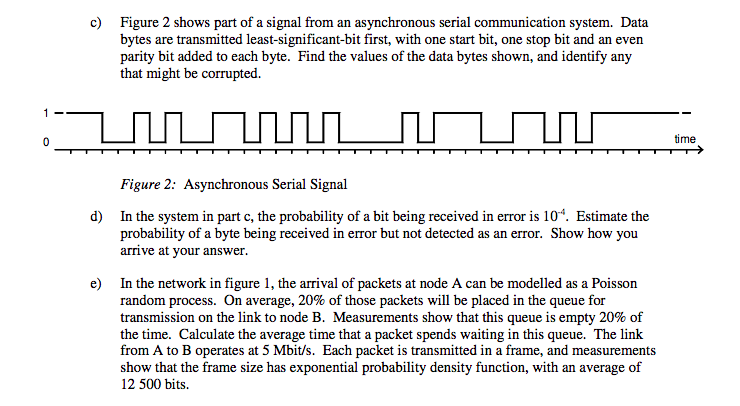
Figure 2 shows part of a signal from an asynchronous serial communication system. Data bytes are transmitted least-significant-bit first, with one start bit, one stop bit and an even parity bit added to each byte. Find the values of the data bytes shown, and identify any that might be corrupted c) ime Figure 2: Asynchronous Serial Signal d) In the system in part c, the probability of a bit being received in error is 104. Estimate the probability of a byte being received in error but not detected as an error. Show how you arrive at your answer In the network in figure 1, the arrival of packets at node A can be modelled as a Poisson random process. On average, 20% of those packets will be placed in the queue for transmission on the link to node B. Measurements show that this queue is empty 20% of the time. Calculate the average time that a packet spends waiting in this queue. The link from A to B operates at 5 Mbit/s. Each packet is transmitted in a frame, and measurements show that the frame size has exponential probability density function, with an average of 12 500 bits. e) Figure 2 shows part of a signal from an asynchronous serial communication system. Data bytes are transmitted least-significant-bit first, with one start bit, one stop bit and an even parity bit added to each byte. Find the values of the data bytes shown, and identify any that might be corrupted c) ime Figure 2: Asynchronous Serial Signal d) In the system in part c, the probability of a bit being received in error is 104. Estimate the probability of a byte being received in error but not detected as an error. Show how you arrive at your answer In the network in figure 1, the arrival of packets at node A can be modelled as a Poisson random process. On average, 20% of those packets will be placed in the queue for transmission on the link to node B. Measurements show that this queue is empty 20% of the time. Calculate the average time that a packet spends waiting in this queue. The link from A to B operates at 5 Mbit/s. Each packet is transmitted in a frame, and measurements show that the frame size has exponential probability density function, with an average of 12 500 bits. e)







